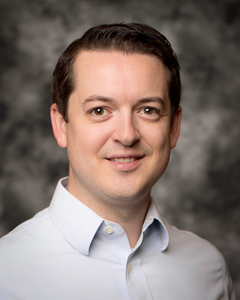Ultra-Low-Power Integrated Circuits and Physiochemical Sensors for Next-Generation “Unawearables”
The IEEE invites you to a Distinguished Lecture by Prof. Patrick Mercier, UC San Diego, titled “Ultra-Low-Power Integrated Circuits and Physiochemical Sensors for Next Generation "Unawearables” in the A.V. Williams Building, Room 2460, University of Maryland, College Park MD on Sep 25th, 2019. The night begins at 6:30 pm with a reception followed by the lecture from 7:15 - 8:30 pm.
Sponsored by
IEEE Washington/Northern Virginia Microwave Theory and Techniques Chapter
IEEE Washington/NoVA/Baltimore Circuits and Systems Chapter
IEEE Washington/NoVA Sensors Council Chapter
IEEE Baltimore Chapter of Electron Devices and Solid-State-Circuits
Date and Time
Location
Hosts
Registration
-
 Add Event to Calendar
Add Event to Calendar
- 8223 Paint Branch Drive
- College Park, Maryland
- United States 20814
- Building: A.V. Williams Building
- Room Number: 2460
- Contact Event Host
- Co-sponsored by Bob Benoit, Pamela Abshire, Paul Potyraj
Speakers
 Prof. Patrick Mercier of University of California, San Diego
Prof. Patrick Mercier of University of California, San Diego
Ultra-Low-Power Integrated Circuits and Physiochemical Sensors for Next-Generation “Unawearables”
Wearable devices hold considerable promise to diagnose, monitor, and treat various medical conditions and/or track the real-time status of athletes. However, most current generation wearable devices only monitor a limited number of physical and electrophysiological parameters that are, in many cases, only peripherally related to many health conditions or fitness enterprises. Furthermore, many such wearable devices are large, bulky, and rigid, thereby precluding seamless integration into daily life.
Addressing these issues requires: 1) development of new sensor technologies that provide more actionable data in thin, flexible form factors; 2) engineering of supporting electronic infrastructure to condition, digitize, and wirelessly communicate data in an extremely energy efficient manner; and 3) new data analytics to process and understand newly generated data streams. This presentation will discuss emerging sensor technologies that can non-invasively monitor physiochemistry (e.g., glucose, blood alcohol concentration, and lactate) in thin, flexible, and energy-efficiency wearable devices, alongside a brief look at what kind of analytics are necessary to parse and understand this data. We will also cover integrated circuit building blocks and architectures that make acquisition and telemetry of sensed information so energy-efficient that that they can be easily powered from new local energy sources (e.g., wearable glucose biofuel cells). Such net-zero-power operation will ultimately enable devices that are completely autonomous and invisible to the user, to the point where users are virtually unaware of their wearable devices after placement – in other words, they are “unawearable” devices.
Biography:
Patrick Mercier is an Associate Professor of Electrical and Computer Engineering and co-founder/co-director of the Center for Wearable Sensors at UC San Diego. He received his B.Sc. degree from the University of Alberta, Canada, in 2006, and the S.M. and Ph.D. degrees from MIT in 2008 and 2012, respectively. Prof. Mercier has received numerous awards, including the NSF CAREER Award in 2018, the Biocom Catalyst Award in 2017, the UCSD Academic Senate Distinguished Teaching Award in 2016, the DARPA Young Faculty Award in 2015, the Beckman Young Investigator Award in 2015, The Hellman Fellowship Award in 2014, the International Solid-State Circuits Conference (ISSCC) Jack Kilby Award in 2010, amongst others. He has published over 110 peer-reviewed papers in venues such as Nature Biotechnology, Nature Communications, ISSCC (13 papers in the last six years), Advanced Science, and others. He is an Associate Editor of the IEEE Transactions on Biomedical Circuits and Systems and the IEEE Solid-State Circuits Letters, is a member of the ISSCC, CICC, and VLSI Technical Program Committees, and has co-edited two books: Power Management Integrated Circuits (CRC Press, 2016), and Ultra-Low-Power Short-Range Radios (Springer, 2015). His research interests include the design of energy-efficient mixed-signal systems, RF circuits, power converters, and sensor interfaces for wearable, medical, and mobile applications.
Address:United States
Agenda
6:30 - 7:15 PM : Social / Networking
7:15 - 8:30 PM : Lecture / Q&A
There is no registration fee but please register so we have a head count for meals.
Public transportation
Check https://www.wmata.com/ for travel details. Please note that the Green/Yellow College Park / University of Maryland station is the closest, but you must take a bus / taxi / Uber / Lyft from the station to the A.V. Williams Building.
Directions and parking
The A.V. Williams Building is Building #115 on the campus map.
Refer to https://transportation.umd.edu/parking/maps/umd-campus-parking-map for directions to visitor parking.
There are several parking lots nearby that offer free parking after 4pm. Options include lot H, CC1, FF2, and lots B and RR in the Regents Drive Garage. Handicapped parking is available in GG2.
Be careful to check the signposts in the parking lots for updated information when you arrive.
Available lots will state that they are "Unrestricted after 4PM".

